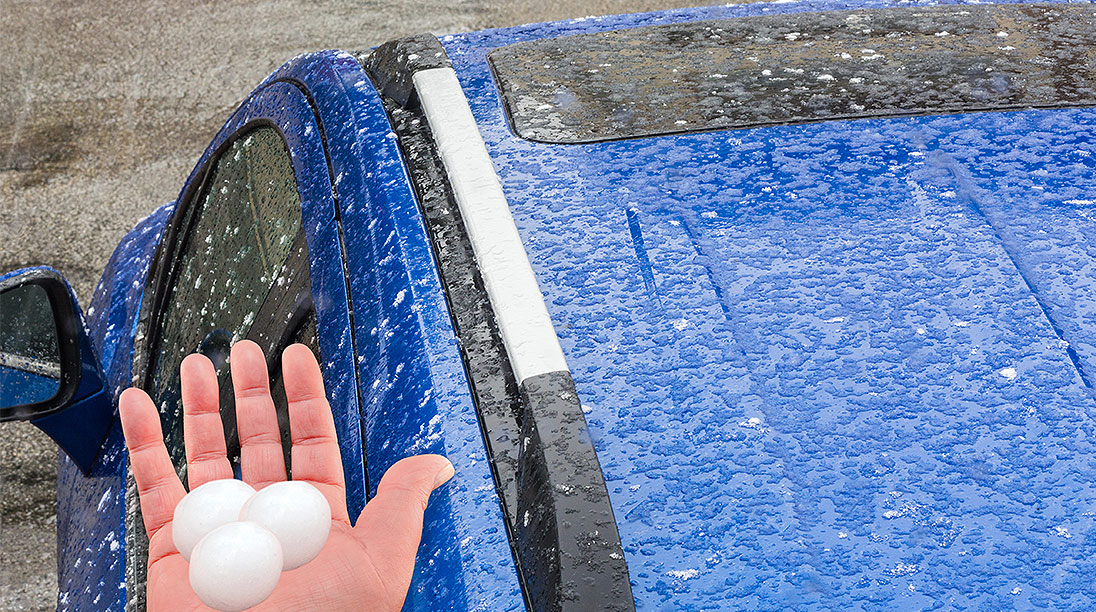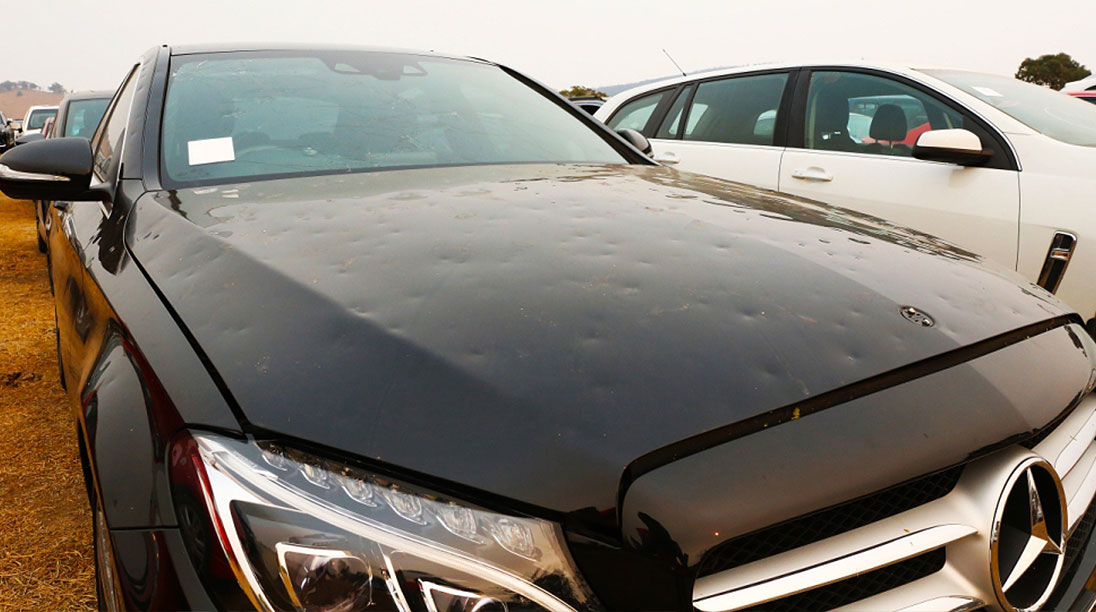GoAutoNews Premium has been told of rising premiums (in one case rising from $700,000 a year to $1.6 million) that are giving many auto businesses no option but to spend on hail protection netting to either prevent premium cost increases or to give insurers comfort that they can in fact reduce hail damage risk and therefore premium costs.
Vehicle and industrial asset auctioneer Manheim this week told GoAutoNews Premium it had spent about $5m on large-scale protective canopies to minimise or avert any damage to its open storage areas.
In Manheim’s case the infrastructure spend came after expensive lessons learnt by the increasingly unpredictable nature of storms and Manheim’s own experience in Sydney in December 2018 when claims hit almost $700m in asset and property damage.
A chronology of hail damage affecting car dealers – where vehicles are usually exposed to the weather in open areas – includes a December 2019 storm that the Insurance Council of Australia (ICA) said resulted in smashed windscreens and glass, dented panels and other damage to 95,000 vehicles and a total claim of almost $1.3 billion.
In an almost annual event, the 2019 episode was followed by a hail storm in January 2020 that hit Canberra, eastern Melbourne and parts of NSW with claims that opened at $320m and promptly rose to more than $1b, of which two-thirds were for damage to vehicles.
This 2020 event damaged an estimated 50,000 dealer and private vehicles with some estimates of up to 10,000 vehicles damaged in Canberra alone.
But the automotive industry and its allied industries are increasingly better prepared to brace themselves for seemingly annual storms that produce vehicle damage from hail.
Accounting and advisory practice Pitcher Partners is well aware of the cost and told GoAutoNews Premium that in some cases, the cost of hail cover has increased by $1m or more over the past two years for individual businesses .
One of the firm’s partners, Steve Bragg, told GoAutoNews Premium that “insurance premiums for hail damage insurance coverage are going through the roof”.

“Allianz is the only provider of hail insurance to the full value of the claim while other insurance providers cap the total claim value which can be very troublesome for dealers,” Mr Bragg said.
Manheim has shown that one way to avoid the damage bill – both from the storm and the insurance premiums – is to invest in protection of a different kind.
It has fitted nets at three of its premises to ensure the on-site protection of customer vehicles and assets.
Cox Automotive Australia & New Zealand director of marketing and communications Mathew McAuley said Manheim last year awarded a contract to MakMax Australia to design and build large-scale protective canopies at its auction sites in Melbourne, Sydney and Brisbane.
“MakMax was chosen as the supplier due to their experience and credentials, having already built numerous structures around Australia for automotive OEMs and 3PL companies,” he said.
“The state-of-the-art canopies protect vehicles onsite from damage during extreme weather events like the catastrophic hail storm that impacted Sydney in December 2018, which resulted in $675m worth of property and asset insurance claims.”
Mr McAuley said Manheim’s infrastructure investment was worth about $5m.
The structures can accommodate and protect more than 6000 vehicles across the three Manheim sites.
“The Melbourne works are almost complete, with Brisbane due for completion in May and Sydney to follow soon after,” he said.

Mat McAuley
Manheim CEO Charles Cumming said: “This project represents a significant investment in our facilities and combined with our existing undercover storage areas, ensures Manheim can provide extensive protection for our customer’s assets.
“These structures provide sellers with confidence their vehicles will be protected whilst on site – whether they’re on display or in storage awaiting allocation to an auction,” Mr Cumming said.
Pitcher Partners’ Mr Bragg said: “Some hail insurance policies are capped at a maximum value for the claim but the A, B and C formula claim value may be higher than the dealer’s maximum cap and therefore the claim may be adjusted down to the lower capped claim value.
“The capped claim value may present significant cashflow issues for dealers that have damage to their vehicle stock in excess of the insurance claim.”
He said that hail-insured cars needed to be assessed on a timely basis.
“The insurance assessor will classify damaged vehicles as category A, B or C depending on the amount of damage,” he said.
“These categories are then given a standard value claim per car in the stock listings for the overall claim.”
Mr Bragg said it was important that the dealer be wary of public expectations and media hype surrounding the value of the hail damage discount.
He said this can work in the favour of the dealer, but warned that it could also be detrimental to potential gross margins.
“Dealers can consider the ‘road to a sale’ by building value in hail-damage cars and not merely offering a hefty discount to get the sale.”
Mr Bragg said hail damage was not the only issue to watch in the aftermath of a storm.

He said some insurance policies also allow for a business interruption claim.
“A loss of trading income is associated with the storm and this includes loss of power, communication lines, computer servers or even stock shortages caused by the knock-on effects of the storm damage,” he said.
“It is important to take time to review the policy to ensure you’re covered and claim everything available under the policy.
“You may need to seek specialist advice. There may be specific formulas applied by insurance companies which will require your unique sales and/or gross data to be entered.
“Some insurance companies require the claim submission to be verified by a third party which may add time to the process.”
Another point that new-car dealers must consider is that the OEM or franchise distributor may have a view on the warranty of vehicles damaged by hail.
“Dealers will be obliged to obtain a disclaimer or acknowledgement from customers that the car was hail-damaged,” he said.
“They will not then claim rectification work under warranty for the hail damage or any further damage incurred on the car at a later date that may stem from the hail damage.”
Mr Bragg also said that stamp duty in most states is assessed on the vehicle’s dutiable value which is the purchase price or the vehicle’s market value, whichever is higher. Some states assess on the sale price or market value, whichever is higher.
He said dealers can also contact the MTAs or VACC for additional information and guidance, and seek relief from the business effects of natural disasters through sources such as the Australian Taxation Office’s website.

Steve Bragg
“Some dealerships may qualify for deferral of certain tax payments,” Mr Bragg said.
There are other considerations including the delays in getting vehicles repaired from hail damage. Mr Bragg said Canberra had more than 10,000 vehicles damaged after the January 2020 storm which put pressure on repair centres.
A large amount of vehicles coming out of repair and onto the used-car market would also affect prices.
The tax issues also need attention. Mr Bragg said if a new car is hail damaged it can be sold as a used car.
“The luxury car tax (LCT) would still apply even though it’s being sold as a used vehicle,” he said.
“This is because the LCT has not been previously paid and so it is not exempt.
“If the insurance assessor writes off a hail-damaged used car, the input tax credits are not able to be claimed back in the dealer’s BAS. This is because most insurance claims are paid exclusive of GST.”
If the dealer is holding damaged new or used cars by June 30, 2021, there will be some income tax adjustments.
The Australian Automotive Dealer Association (AADA) said that there was “no doubt” that hail was front of mind for so many dealerships given the events of recent years.
AADA CEO James Voortman said dealers were also very aware that with the hail comes skyrocketing insurance premiums.
“Dealers will no doubt be considering and implementing risk mitigation strategies,” he said.
“Given the supply constraints we have at the moment, the industry can ill afford to lose any inventory.
“Furthermore, it may be challenging responding to customer demand for vehicles which may come about as a result of a significant hail storm.”
By Neil Dowling












 Read More: Related articles
Read More: Related articles

